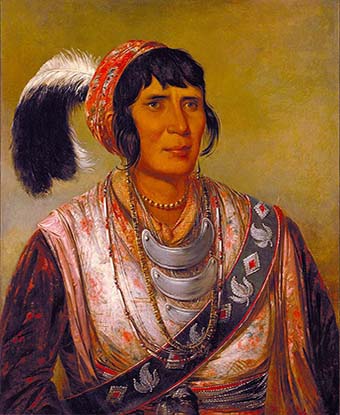Last updated: February 11, 2021
Person
Osceola

Smithsonian American Art Museum
During the 1830s, Osceola, a Seminole warrior, led members of his tribe in Florida in a valiant attempt to resist the US Army’s efforts to forcibly deport them to a reservation west of the Mississippi River. After being captured under a false flag of truce, Osceola died a prisoner of the US Army at Fort Moultrie in January 1838. He is buried outside of the fort’s sallyport.
Osceola’s early life is largely unknown. Historians believe he was born in Alabama in 1804 to a Creek mother and a Scottish father. As a child, Osceola went by the name Billy Powell, but later he fully embraced the identity of his adopted tribe, the Seminoles of Florida. Osceola and his mother were one of many Creek families displaced after the Creek War of 1813-1814. They moved from Mississippi Territory to Spanish-held Florida, beginning his transition from Billy Powell to Osceola, Seminole warrior. The Seminoles also welcomed runaway enslaved people from the plantations of Georgia, South Carolina, and later Florida into their tribe, which drew the attention and hostility of American slaveholders and the US Army.
He acquired the name Osceola in young adulthood. Osceola means black drink singer. During purification rites, a Seminole warrior drinks a black purgative liquid brewed from yaupon holly leaves. Unfortunately for Osceola, Florida proved to be a short-lived safe haven from American expansion and armed conflict. Spain ceded Florida to the United States in 1819 in the Adams-Onis Treaty, following the First Seminole War, in which General Andrew Jackson invaded Spanish Florida.
By the Treaty of Moultrie Creek of 1823, the Seminoles agreed to give up their claims to land in Florida Territory in return for a reservation in central Florida, as well as certain payments and supplies to be provided by the US government. The land, however, was unsuitable for agriculture and located away from the coastline so that Seminoles could no longer trade with Cubans and others for arms, ammunition, etc.
The Indian Removal Act of 1830, signed by President Andrew Jackson, posed the greatest threat to Osceola's desire for Seminole autonomy. Between 1832 and 1838, this federal legislation directed the deportation of the Cherokee, Creek, Choctaw, Chickasaw, and Seminole tribes west of the Mississippi River to Indian Territory, present-day Oklahoma. The 1832 Treaty of Payne’s Landing called for the Seminoles to move west of the Mississippi and settle on the Creek reservation. Seminoles, especially refugees from the Creek War and Black Seminoles, who feared re-enslavement, feared the move and resisted inclusion with the Creeks. Many Seminole chiefs refused to sign the treaty, leading to the outbreak of the Second Seminole War and Osceola’s fame.
The Second Seminole War, fought from 1835-42, was the longest and most costly war between Native Americans and the United States. For every four Seminoles deported, the US Army killed one Seminole, lost three US Army soldiers, and spent $32,000. In today's dollars, for every Seminole person shipped west, the government spent the equivalent of $8.5 million.
Osceola quickly proved to be a talented tactician and capable leader. He defeated General Duncan Clinch at the Battle of Withlacoochee in December 1835. He directed a successful ambush, taking advantage of the army’s river crossing. Osceola managed to lead his followers, including noncombatants, from safe haven to ambush site to safe haven, while eluding multiple armies. The army was unable to defeat Osceola in the field, so General Thomas Jesup used other means to capture him.
In October 1837, while negotiating under a white flag of truce near St. Augustine, Florida, Osceola was taken prisoner. While Osceola’s capture relieved many anxious white Floridians, there was also public outcry at the dishonorable ploy employed by Jesup. Osceola was imprisoned at Fort Marion under the guardianship of Captain Pitcairn Morrison of the 4th US Infantry. In December 1837, about twenty Seminole warriors escaped from their cell in Fort Marion. Osceola, suffering from failing health, was too weak to scale the walls of the cell and escape with his fellow warriors. As a result of the escape, Osceola and 237 of his people were transferred to Fort Moultrie, South Carolina, far from their homes in Florida.
Osceola, suffering from poor health, spent his final month at Fort Moultrie as a prisoner of the US Army. George Catlin, the famous artist who focused on Native American culture, visited and painted Osceola in his full Seminole attire: ostrich plumes, turban, war dress, and gorget. Osceola, surrounded by his two wives and children, died the evening of January 30, 1838. Known for his resistance to the United States and its military, Osceola’s final resting place outside of the sallyport of Fort Moultrie is surrounded by visual reminders of the army and is a place to reflect on his legacy.
Sources:
Porter, Kenneth. The Black Seminoles: History of a Freedom-Seeking People. University of Florida Press, 1996.
Sant, Claudio. Unworthy Republic: The Dispossession of Native Americans and the Road to Indian Territory. W.W. Norton & Company, New York, New York, 2020.
